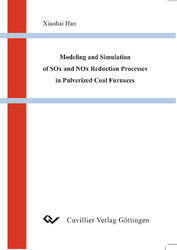| Departments | |
|---|---|
| Book Series (96) |
1378
|
| Nachhaltigkeit |
3
|
| Gesundheitswesen |
1
|
| Humanities |
2365
|
| Natural Sciences |
5406
|
| Engineering |
1793
|
| Engineering | 292 |
| Mechanical and process engineering | 862 |
| Electrical engineering | 686 |
| Mining and metallurgy | 30 |
| Architecture and civil engineering | 75 |
| Common |
98
|
|
Leitlinien Unfallchirurgie
5. Auflage bestellen |
|
Advanced Search
Modeling and Simulation of SOx and NOx Reduction Processes in Pulverized Coal Furnaces (English shop)
Xiaohai Han (Author)Preview
Table of Contents, Datei (110 KB)
Extract, Datei (160 KB)
ABSTRACT The current work briefly reviews the formation mechanisms and reduction approaches of the pollutants SOx and NOx in coal combustion and focuses on the simulation of the lower-cost in-furnace measures ƒ{ the dry additive process (DAP) for SOx reduction and the reburning as well as the advanced reburning (hybrid reburning/SNCR) techniques for NOx reduction. In addition, the influence of sulfur compounds on NOx formation is investigated. The major workings include: Simulation of the dry additive desulfurization process (DAP): Different models ƒ{ shrinking core model (SCM), pore model (PM) and grain model (GM) ƒ{ are implemented to describe the gas-particle reaction. Relevant processes such as the sintering of the additive, the self-retention by coal ash, the thermal equilibrium of the sulfation reaction are accounted for and modeled. A comprehensive model for the DAP with calcium based additives is subsequently established and integrated into a combustion CFD (computational fluid dynamics) code AIOLOS, in both Eulerian and Lagrangian schemes. The model is verified with experiments on a test reactor. Mechanism reduction and simulation of reburning/SNCR Processes: A method for reduction of kinetic mechanisms is introduced. A program tool is developed for automatic reduction of detailed reaction mechanisms. Reduced mechanisms for reburning and hybrid reburning/SNCR processes are developed and implemented into the CFD code. CFD-calculations with the reduced mechanisms are performed and compared with experimental measurements to comprehensively evaluate the simulation approach. It is shown that the detailed simulation is capable of modeling the complex reburning and SNCR processes with acceptable computing time and achieves reasonable results in wide parameter ranges. Study of the influence of sulfur compounds on NOx formation: The effect of SO2 on NOx formation is experimentally investigated and analysed with kinetic mechanisms. It is indicated that the presence of SO2 inhabits the NOx formation and reduce the NOx emissions in normal air-rich combustion. Under air-staging conditions, SO2 addition has no obvious influence on the final NOx emissions.
| ISBN-13 (Printausgabe) | 3898739384 |
| ISBN-13 (Hard Copy) | 9783898739382 |
| ISBN-13 (eBook) | 9783736909380 |
| Language | German |
| Page Number | 180 |
| Edition | 1 |
| Volume | 0 |
| Publication Place | Göttingen |
| Place of Dissertation | Göttingen |
| Publication Date | 2003-12-18 |
| General Categorization | Dissertation |
| Departments |
Mechanical and process engineering
|








